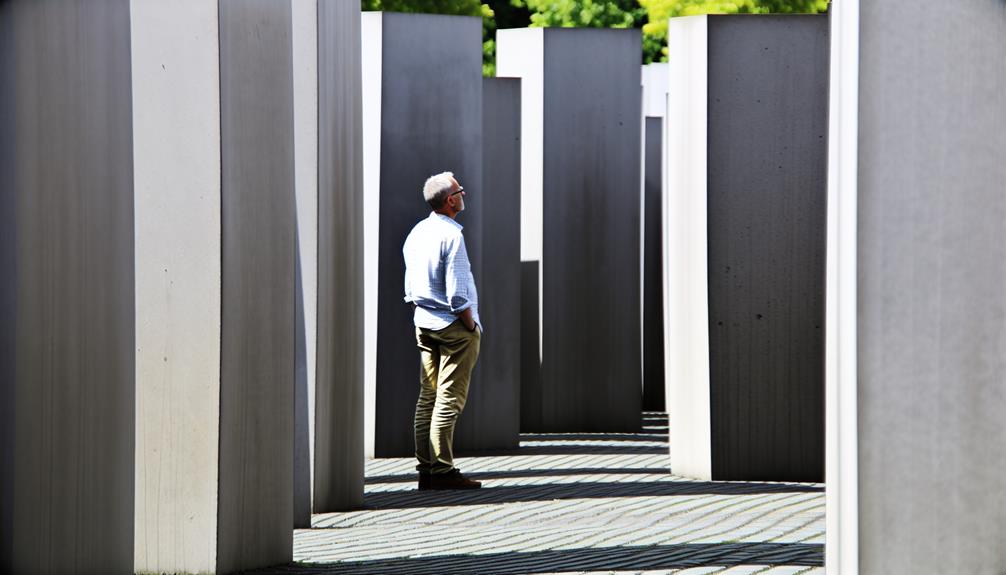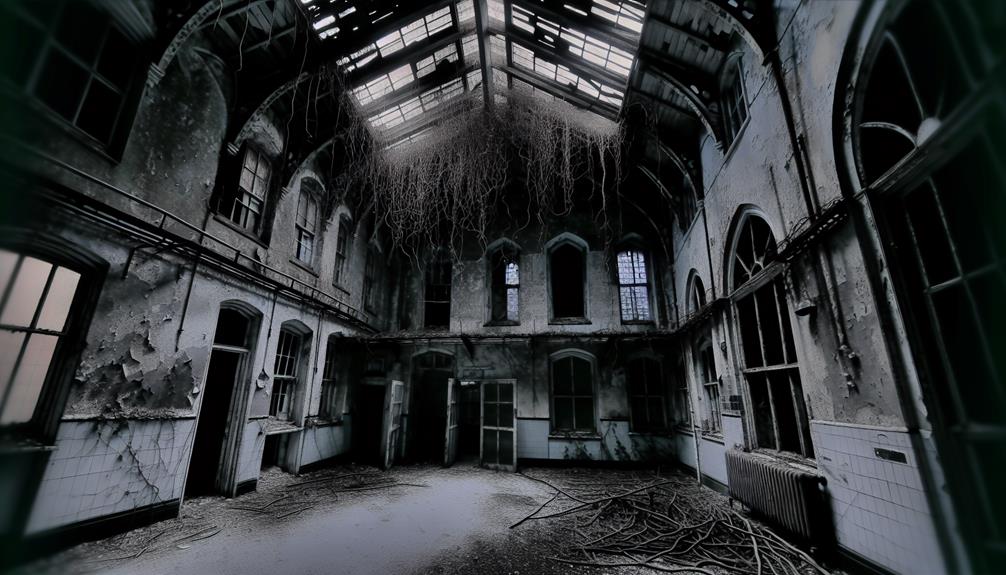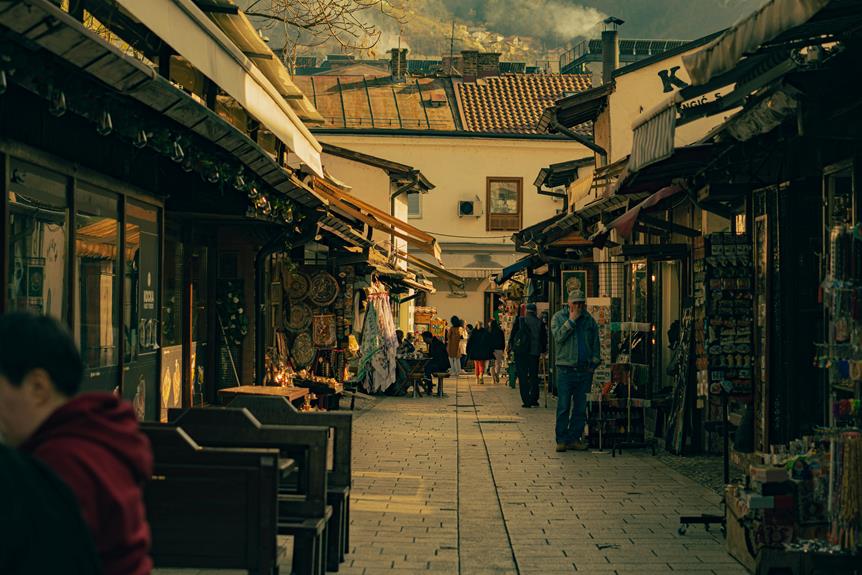The Holocaust Memorial in Berlin stands as a solemn tribute to the atrocities of the past, inviting visitors to engage with history in a profound and introspective manner. The stark architecture and expansive layout of the memorial serve as a stark reminder of the immense loss and suffering endured during one of humanity's darkest chapters. As visitors traverse the maze-like structure, they are confronted with a haunting silence that speaks volumes about the magnitude of the tragedy. This poignant setting invites contemplation on the fragility of peace and the resilience of the human spirit, leaving visitors with a lingering sense of introspection and a call to remember the voices silenced by hatred and intolerance.
Key Takeaways
- The memorial's design symbolizes the Holocaust's chaos and loss, evoking deep emotional responses.
- Visitors experience a somber and reflective atmosphere, fostering unity in remembrance.
- Personal reflection on the Holocaust's impact is encouraged through the overwhelming scale and layout.
- The memorial serves as a stark reminder of historical atrocities, emphasizing the importance of understanding and remembrance.
- Educational resources and exhibits shape collective memory, highlighting the lessons of social responsibility and compassion for the future.
The Memorial's Design and Layout
The design and layout of the Holocaust Memorial in Berlin meticulously embody a somber and reflective atmosphere, inviting visitors to engage with the historical significance of the site. Architectural elements play a vital role in shaping this experience. The memorial spans 4.7 acres and consists of 2,711 concrete slabs, known as stelae, arranged in a grid pattern. The varying heights of the stelae create an undulating ground, symbolizing the unpredictability and turmoil of the Holocaust. This spatial arrangement allows visitors to wander through the memorial, feeling both isolated and overwhelmed by the enormity of the structure.
The architectural elements, such as the stelae's cold, grey concrete and the labyrinthine layout, evoke a sense of disorientation and unease, mirroring the confusion and despair felt by victims of the Holocaust. The vast expanse of the memorial encourages introspection and contemplation, prompting visitors to confront the atrocities of the past. The spatial arrangement also facilitates a feeling of isolation, as visitors may find themselves surrounded by towering slabs, cut off from the outside world.
Symbolism in Architecture and Art
Symbolism plays a profound role in both architecture and art, serving as a powerful tool to convey deeper meanings and evoke emotional responses from viewers. In the context of the Holocaust Memorial in Berlin, symbolic representation is intricately woven into the architecture and art pieces that compose the memorial. The design elements, such as the grid layout of concrete slabs, are not merely structures but symbolic representations of the systematic dehumanization and confinement experienced during the Holocaust.
Artistic interpretation can be seen in the way the slabs vary in height and create an uneven ground, symbolizing the erratic and unpredictable nature of the events that occurred during the Holocaust. The use of negative space between the slabs can be interpreted as representing the void left by the millions of lives lost. Additionally, the stark gray color of the slabs and the somber atmosphere within the memorial evoke a sense of mourning and remembrance.
Through the combination of architectural design and artistic elements, the memorial succeeds in creating a space that goes beyond physical structures. It becomes a place where visitors can engage with history on a profound emotional level, reflecting on the past while also contemplating the present and future.
Visitor Experience and Emotions
In the context of the Holocaust Memorial in Berlin, visitors are confronted with a deeply emotive and thought-provoking experience as they engage with the memorial's design and artistic elements. The emotional impact of the memorial is profound, evoking a range of feelings and personal reflections among those who visit. Here are three key aspects that contribute to visitors' experiences and emotions at the Holocaust Memorial:
- Sensory Overload: The sheer scale of the memorial, with its grid of concrete slabs or stelae varying in height, can be overwhelming. Visitors often describe feeling a sense of disorientation and unease as they navigate through the unevenly rising and falling blocks. This deliberate design aims to evoke a feeling of isolation and confusion, mirroring the experiences of the victims of the Holocaust.
- Silent Contemplation: The quiet and somber atmosphere of the memorial encourages visitors to reflect on the atrocities of the Holocaust in a personal and introspective manner. The absence of explicit symbolism or narrative allows individuals to form their interpretations and connect with the history on a deeply emotional level.
- Unity and Diversity: Despite the individualized experience, the collective presence of visitors from around the world fosters a sense of unity in remembrance. The diverse backgrounds and perspectives of visitors contribute to a shared emotional journey, emphasizing the universal significance of honoring the victims and survivors of the Holocaust.
Historical Context and Significance
Within the historical narrative surrounding the Holocaust Memorial in Berlin, the intricate layers of context and significance intertwine to create a profound expression of the enduring impact of collective remembrance. The memorial stands as a poignant reminder of one of the darkest chapters in human history, honoring the millions of lives lost during the Holocaust. Its design, consisting of 2,711 concrete slabs of varying heights arranged in a grid pattern, symbolizes the systematic dehumanization and eradication of individuals by the Nazi regime.
The historical context of the memorial is deeply rooted in the atrocities committed during World War II, serving as a physical representation of the unimaginable suffering endured by victims. It provides a space for impactful remembrance, allowing visitors to reflect on the horrors of the past and pay tribute to those who perished. The memorial's cultural significance extends beyond its physical presence, acting as a solemn tribute to the resilience of the human spirit in the face of adversity.
Contemplating Tragedy and Loss
The process of contemplating tragedy and loss at the Holocaust Memorial in Berlin necessitates a somber introspection into the depths of human suffering and resilience. The emotional response evoked by the memorial's stark design and vast expanse can lead visitors to engage in profound philosophical reflection on the atrocities committed during the Holocaust.
Here are three key aspects to bear in mind when reflecting on tragedy and loss at this memorial:
- Symbolism and Architecture: The towering concrete slabs that make up the memorial, known as the Memorial to the Murdered Jews of Europe, create a sense of disorientation and unease, symbolizing the chaos and destruction of the Holocaust. Visitors wandering through the maze-like structure may experience a range of emotions, from sadness to contemplation.
- Individual Reflection: Each visitor's emotional response to the memorial is deeply personal. Some may feel overwhelming grief, while others might be filled with anger or disbelief. This individual reflection allows for a deeper exploration of the impact of tragedy and loss on both a collective and personal level.
- Historical Context: Understanding the historical backdrop of the Holocaust is important when pondering the tragedy and loss memorialized in Berlin. Delving into the events that led to the genocide and the resilience of those who survived can prompt visitors to ponder how such atrocities were allowed to occur and how society can work towards preventing similar tragedies in the future.
Education and Remembrance Initiatives
How do education and remembrance initiatives at the Holocaust Memorial in Berlin contribute to preserving the memory of the victims and educating future generations about the horrors of the Holocaust? The Memorial's outreach programs and community engagement efforts play an essential role in guaranteeing that the atrocities of the Holocaust are never forgotten. By actively involving the community in educational initiatives, the Memorial fosters a sense of collective responsibility to remember and honor the victims.
Educational resources and interactive exhibits at the Memorial provide visitors with a thorough understanding of the historical context, the lives lost, and the impact of the Holocaust. These resources serve as powerful tools for educating individuals about the human rights violations and the consequences of prejudice and discrimination. Through interactive exhibits, visitors are encouraged to engage with the exhibits actively, fostering a deeper connection to the history and the individuals affected by the Holocaust.
Moreover, the Memorial's commitment to ongoing educational programs ensures that the lessons of the Holocaust are passed down to future generations. By providing opportunities for learning and reflection, the Memorial equips individuals with the knowledge and understanding necessary to combat intolerance and promote empathy and understanding in society. Through these initiatives, the Memorial continues to be a beacon of remembrance and education, preserving the memory of the victims and advocating for a more just and compassionate world.
Impact on Collective Memory
The educational resources and interactive exhibits at the Holocaust Memorial in Berlin not only serve to educate visitors about the historical context and impact of the Holocaust, but also play a significant role in shaping collective memory regarding the atrocities committed during that period.
Social Responsibility: The memorial prompts individuals to reflect on their social responsibility in preventing such atrocities from happening again. By highlighting the consequences of silence and inaction, it encourages visitors to actively stand against discrimination and injustice in their communities.
Cultural Trauma: Through the depiction of personal stories and historical facts, the memorial contributes to the recognition and understanding of cultural trauma. It helps in acknowledging the deep scars left by the Holocaust on the collective identity of affected communities and the world at large.
Memory Preservation: The memorial serves as a physical embodiment of memory preservation. By providing a space for contemplation and remembrance, it guarantees that the stories of the victims and survivors are not forgotten, fostering emotional resonance among visitors and future generations.
Lessons for the Future
Imparting valuable insights gained from the past atrocities, the Holocaust Memorial in Berlin offers profound lessons that can guide future generations towards a more empathetic and just society. By acknowledging the horrors of the Holocaust, individuals can reflect on the consequences of hatred and discrimination, fostering a collective commitment to never let such atrocities occur again. The memorial serves as a poignant reminder of the importance of forging unity and promoting tolerance in the face of diversity.
One of the key lessons for the future that the Holocaust Memorial imparts is the significance of standing up against injustice. It underscores the importance of speaking out against discrimination and prejudice, even in the face of adversity. By encouraging individuals to take a stand against intolerance, the memorial promotes a society where all individuals are valued and respected, regardless of their background or beliefs.
Moreover, the memorial highlights the power of remembrance in shaping a more compassionate future. By honoring the victims and preserving their stories, the memorial ensures that the atrocities of the past are not forgotten. This act of remembrance instills a sense of responsibility in future generations to uphold the values of empathy, understanding, and acceptance, ultimately working towards a more harmonious and inclusive society.
Frequently Asked Questions
How Can Visitors Contribute to the Preservation of the Memorial?
Visitors can support the preservation of the memorial through various means. Engaging in fundraising events can provide financial assistance, while volunteering offers hands-on support.
Participating in educational programs can spread awareness and promote understanding. Additionally, advocating for public art installations can enhance the memorial's visibility and significance.
Are There Any Specific Rituals or Ceremonies Held at the Memorial?
Memorial etiquette at Holocaust memorials often emphasizes respectful behavior, such as refraining from loud conversations or photography. Commemoration traditions may include laying flowers or stones on memorial structures as a sign of remembrance.
Some visitors engage in moments of silence or reflection to honor the victims. These rituals help create a somber and contemplative atmosphere, allowing visitors to pay their respects in a meaningful way while preserving the sanctity of the memorial space.
Can Visitors Leave Personal Items or Messages at the Memorial?
Visitors to the memorial can leave personal tributes like flowers or candles at designated areas. Additionally, memory stones, often inscribed with messages, can be placed throughout the site as a symbol of remembrance.
These gestures allow individuals to connect on a personal level with the history and significance of the memorial, fostering a sense of reverence and reflection for those impacted by the Holocaust.
Are There Any Plans for Expansion or Additional Features at the Memorial?
While the Holocaust Memorial in Berlin currently stands as a powerful symbol of remembrance, there are plans for future developments to enhance the visitor experience.
Discussions have included the possibility of incorporating public art and interactive installations to further engage visitors and deepen their understanding of the historical significance of the memorial.
Such additions could provide a new layer of immersive storytelling and foster continued reflection on the atrocities of the past.
How Are Survivors of the Holocaust Involved in the Memorial's Activities?
Survivors of the Holocaust play a significant role in the memorial's activities by sharing their testimonies during commemorative events, educational programs, and guided tours. Their participation adds a personal and poignant dimension to the memorial, allowing visitors to hear firsthand accounts of the atrocities committed during that dark period in history.
Conclusion
To sum up, the Holocaust Memorial in Berlin serves as a poignant reminder of the atrocities committed during the Holocaust and the importance of collective remembrance. Through its design, symbolism, and visitor experience, the memorial prompts deep contemplation and emotional responses.
One can imagine a visitor standing amidst the towering concrete slabs, feeling the weight of history bearing down on them, as they reflect on the lives lost and the necessity to guarantee such tragedies are never repeated.


